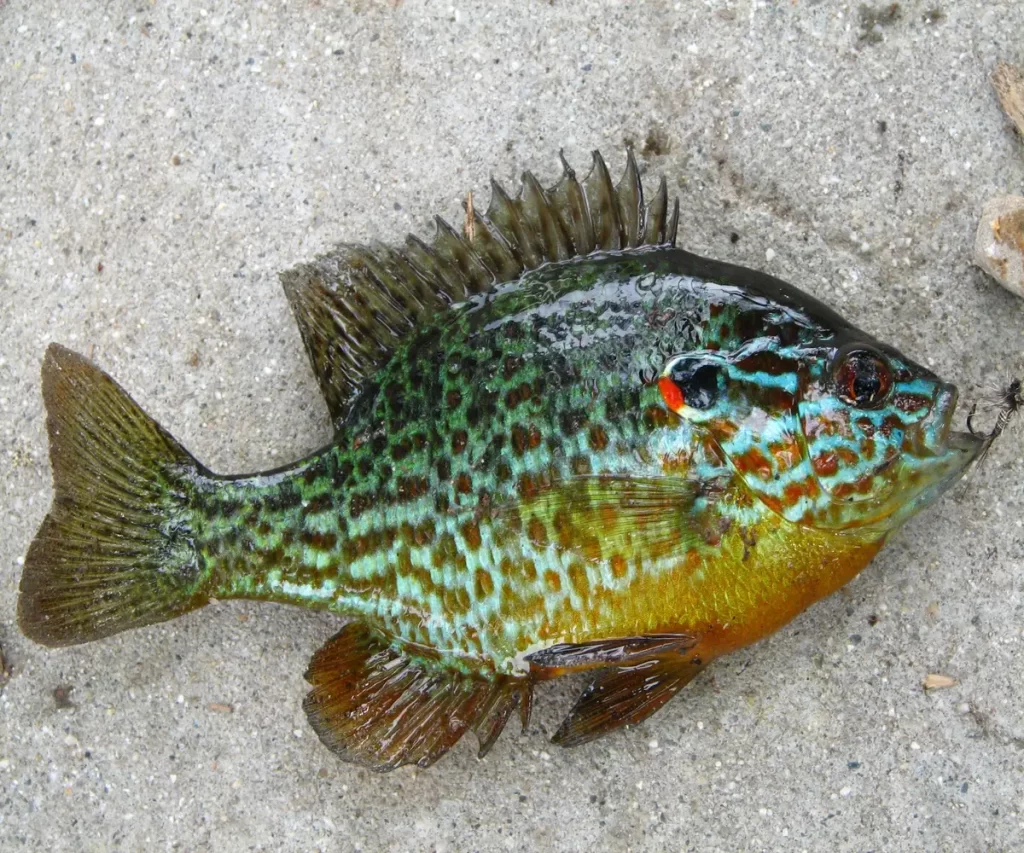
Pumpkinseed Fish Species Guide
Welcome to the fascinating world of the Pumpkinseed (Lepomis gibbosus), a strikingly beautiful and ecologically significant freshwater fish species. This guide aims to provide an in-depth exploration of the Pumpkinseed, covering various aspects such as its physical characteristics, habitat, behavior, ecological role, and importance to both anglers and conservationists.
Taxonomy and Classification
The Pumpkinseed belongs to the sunfish family (Centrarchidae) and the genus Lepomis. Its scientific name, Lepomis gibbosus, reflects its distinctive physical features and helps classify it within the broader realm of freshwater fishes.
Physical Characteristics
The Pumpkinseed is renowned for its vibrant and intricate coloration. Its body is laterally compressed, with a noticeable deep oval shape. The most distinguishing feature is its opercular flap, which resembles a pumpkin seed, hence the common name. The body coloration ranges from olive-green to blue, with a distinctive pumpkin-orange or red spot at the base of the dorsal fin. Dark vertical bars adorn its sides, enhancing its overall aesthetic appeal.
The dorsal fin is spiny, while the anal fin is elongated, contributing to the Pumpkinseed’s distinctive silhouette. Adult specimens typically reach lengths of 4 to 10 inches, although exceptional individuals may grow even larger.
Distribution and Habitat
Pumpkinseeds are native to North America, with their natural range extending from the Great Lakes region down to the Gulf of Mexico. They have also been introduced to various other regions, including parts of Europe and Asia. These fish thrive in slow-moving or still waters, such as ponds, lakes, and slow-flowing streams. Their preference for vegetated areas provides ample cover and a rich supply of food.
Behavior and Diet
Pumpkinseeds are opportunistic feeders, displaying a varied diet that includes aquatic insects, crustaceans, small fish, and plant matter. Their foraging behavior often involves searching for food among submerged vegetation and along the lake or pond bottom. This adaptability contributes to their success in a wide range of aquatic environments.
In terms of behavior, Pumpkinseeds are known for their aggressive nature, especially during the breeding season. They are territorial and will vigorously defend their nests against intruders. These nests, constructed by males, are typically located in shallow areas with a sandy or gravel substrate.
Reproduction and Life Cycle
The Pumpkinseed’s reproductive cycle is a captivating aspect of its biology. Spawning usually occurs in late spring or early summer when water temperatures rise. Males select and prepare nesting sites, often in shallow water near protective cover. The courtship ritual involves vibrant displays of color and fin extensions to attract females.
Once a female selects a mate, she deposits her eggs in the nest, and the male fertilizes them. The male then diligently guards the nest, fanning the eggs with his fins to provide oxygen and protect them from potential predators. After hatching, the young Pumpkinseeds remain under the watchful eye of the male until they are capable of independent living.
Ecological Importance
Pumpkinseeds play a crucial role in freshwater ecosystems, contributing to the delicate balance of aquatic communities. As opportunistic feeders, they help control insect populations and maintain the health of underwater vegetation. Additionally, they serve as a valuable food source for larger predatory fish, birds, and mammals.
The adaptability of Pumpkinseeds to various habitats also makes them important indicators of environmental health. Changes in their populations or behavior can signal shifts in water quality or the overall condition of aquatic ecosystems.
Recreational Fishing and Conservation
Anglers appreciate Pumpkinseeds for their sporting qualities and aesthetic appeal. These fish are often targeted by recreational anglers using light tackle. The thrill of catching a Pumpkinseed, coupled with its striking colors, makes it a prized catch in many freshwater bodies.
While Pumpkinseeds are not typically targeted for commercial fishing, their populations can be affected by habitat degradation, pollution, and the introduction of non-native species. Conservation efforts focus on maintaining suitable habitats, controlling invasive species, and promoting sustainable fishing practices to ensure the continued well-being of Pumpkinseed populations.
Challenges and Conservation Efforts
The introduction of non-native species, habitat loss, and pollution pose significant threats to Pumpkinseed populations. Invasive species such as the Largemouth Bass and Bluegill, which compete for resources and prey on young Pumpkinseeds, can negatively impact their numbers.
Conservation initiatives aim to address these challenges through habitat restoration, invasive species management, and public awareness campaigns. By promoting responsible fishing practices and advocating for the preservation of natural habitats, conservationists work to safeguard the Pumpkinseed and its ecosystem.
Conclusion to: Pumpkinseed Fish
In conclusion, the Pumpkinseed (Lepomis gibbosus) is a captivating fish species that enriches the freshwater landscapes of North America and beyond. From its vibrant coloration and unique physical features to its role in maintaining ecological balance, the Pumpkinseed stands out as a remarkable and ecologically significant member of the sunfish family.
Understanding the intricacies of the Pumpkinseed’s life cycle, behavior, and ecological importance is crucial for both conservationists and recreational anglers. By fostering awareness and implementing conservation measures, we can ensure the continued existence of this beautiful species and the health of the freshwater ecosystems it inhabits. So, whether you’re an avid angler or a nature enthusiast, take a moment to appreciate the colorful world of the Pumpkinseed and contribute to its conservation for generations to come.